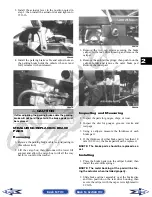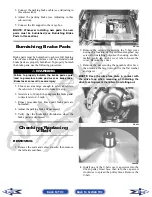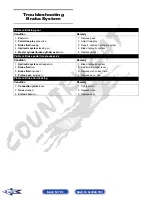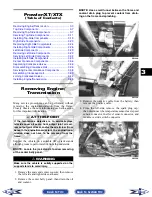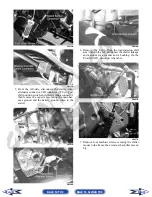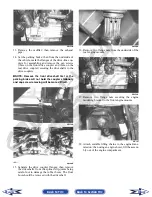
3-11
3
A. Starting with the top ring, slide one end of the
ring out of the ring-groove.
B. Remove each ring by working it toward the
dome of the piston while rotating it out of the
groove.
Servicing Top-Side
Components
NOTE: Whenever a part is worn excessively,
cracked, or damaged in any way, replacement is
necessary.
VALVE ASSEMBLY
When servicing valve assembly, inspect valve seats,
valve stems, valve faces, and valve stem ends for pits,
burn marks, or other signs of abnormal wear.
NOTE: Whenever a valve is out of tolerance, it
must be replaced.
Cleaning/Inspecting Valve Cover
NOTE: If the valve cover cannot be trued, the cyl-
inder head assembly must be replaced.
1. Wash the valve cover in parts-cleaning solvent.
2. Place the valve cover on the Surface Plate covered
with #400 grit wet-or-dry sandpaper. Using light
pressure, move the valve cover in a figure eight
motion. Inspect the sealing surface for any indica-
tion of high spots. A high spot can be noted by a
bright metallic finish. Correct any high spots
before assembly by continuing to move the valve
cover in a figure eight motion until a uniform
bright metallic finish is attained.
CC130D
Removing Valves
NOTE: Keep all valves and valve components as
a set. Note the original location of each valve set
for use during installation. Return each valve set to
its original location during installation.
1. Using a valve spring compressor, compress the
valve springs and remove the valve cotters.
Account for an upper spring retainer.
CC132D
2. Remove the valve seal and the lower remaining
spring seat. Discard the valve seal.
CC136D
NOTE: The valve seals must be replaced.
AT THIS POINT
To service piston, see Servicing Top-Side Compo-
nents sub-section.
AT THIS POINT
To service center crankcase components only, pro-
ceed to Removing Left-Side Components.
! CAUTION
Do not remove an excessive amount of the sealing
surface or damage to the camshaft will result.
Always check camshaft clearance when resurfacing
the valve cover.
! CAUTION
Water or parts-cleaning solvent must be used in
conjunction with the wet-or-dry sandpaper or dam-
age to the sealing surface may result.
Back to TOC
Back to Section TOC
Next
Back

